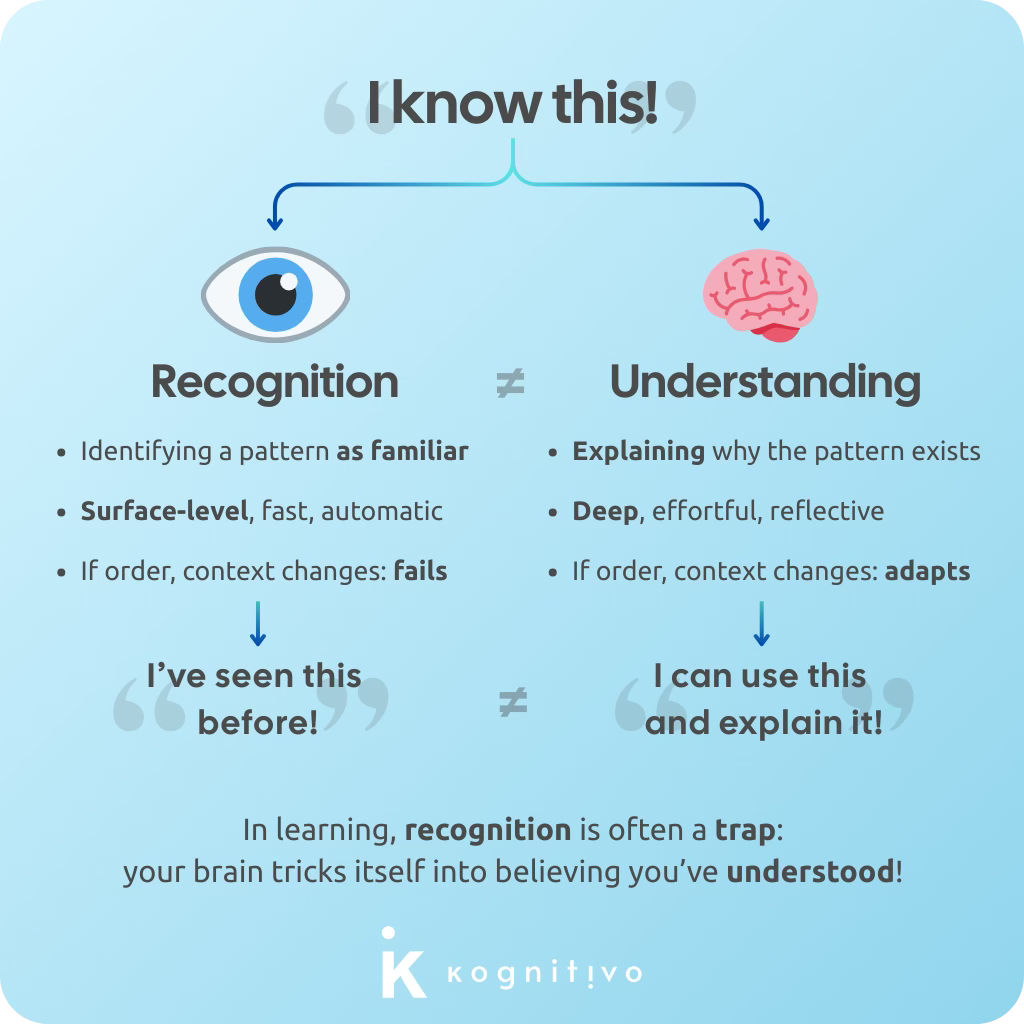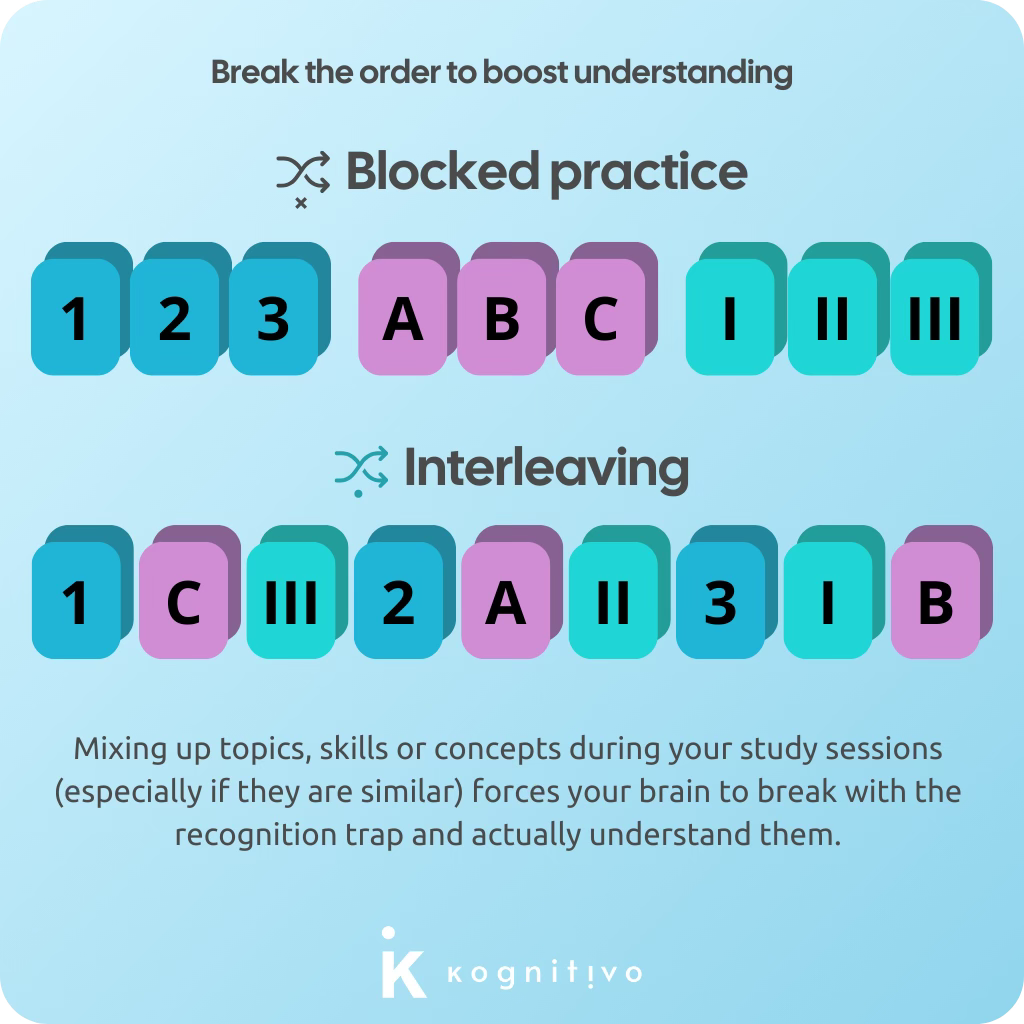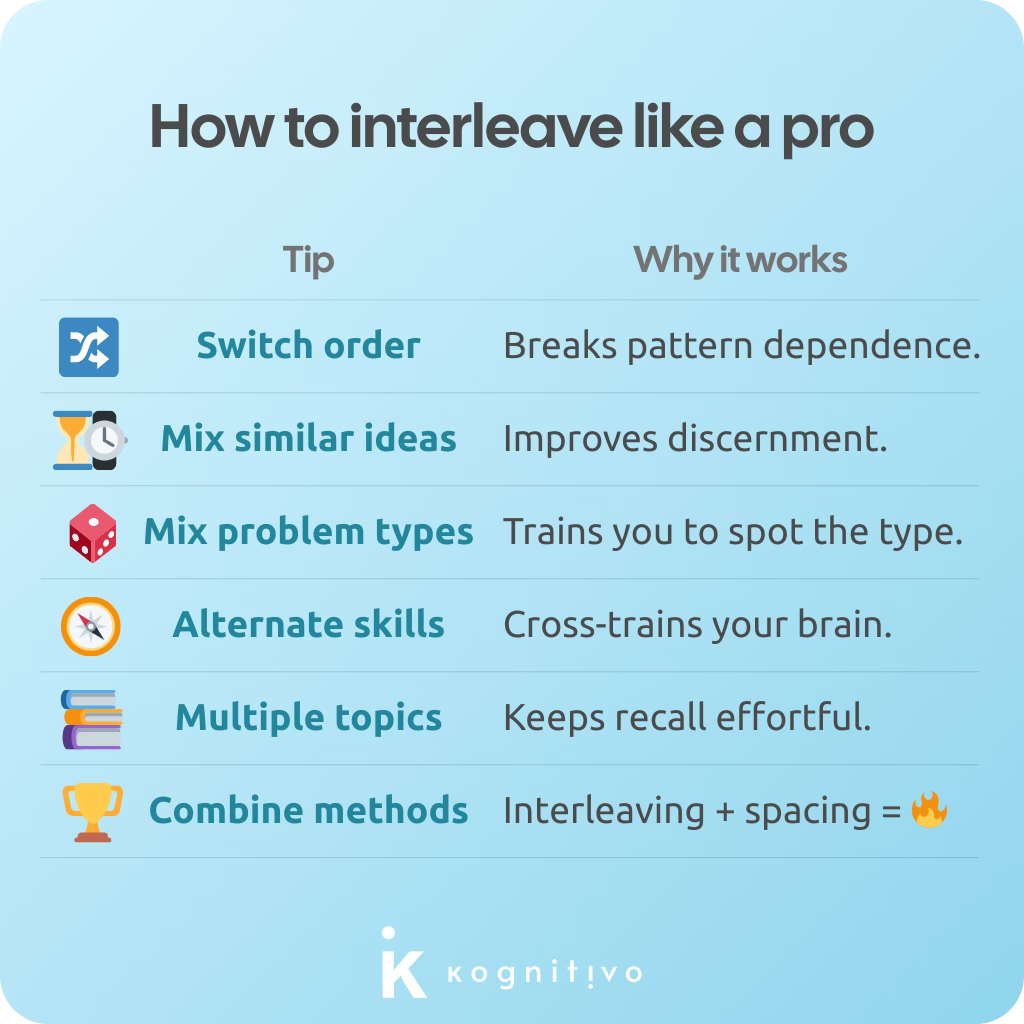The case against learning in perfect order: interleaving
Interleaving topics while you study is proven to make your learning more efficient, because it prepares you for the unpredictability of real life.
Imagine this: you’ve rehearsed your big speech like a pro: paragraph by paragraph, in perfect order, just like your outline says. Paragraph 1? Nailed it. Paragraph 2? Smooth. Paragraph 3? Oscar-worthy. You’re feeling unstoppable.
But then… someone raises their hand. A question. Off-script. Suddenly you’re blinking like a deer in headlights. Wait, where was I? Was that point in paragraph 2 or 4? Why is my mouth moving and nothing’s coming out?
It’s not that you don’t know your stuff. You do. But your brain’s only ever practiced it in a perfect, linear order. And real life doesn’t care about your outline.
Learning in order feels good, but it tricks your brain into relying on routine. When that routine breaks, so do you. Interleaving helps by mixing things up during practice. It’s harder, but it trains your brain to be flexible, not just fluent in a script.
Recognition is a trap
But before we dive into interleaving, let’s talk about what’s happening here. Your enemy has a name: recognition.
In cognitive science, recognition is the ability to identify something as familiar. It’s when you say: “Oh! I’ve seen this before”. Recognition picks up patterns and cues, but stays on the surface. It’s a distinct, low-effort cognitive process.
In learning, recognition is often a self-defeating trap! Our brains tend to unconsciously focus our learning around recognition instead of understanding, as a way to trick you into believing you truly mastered something.
It’s like a default shortcut your brain likes to take, because it’s less demanding. And it often happens without you realizing it… that’s why you need to fight against it!
As opposed to recognition, understanding (or comprehension) involves deep processing: being able to explain topics, implement them, use them in different contexts, make logical connections, etc.
When you read a flashcard and think “I know this!”, it’s often just “I’ve seen this before!” The verb “to know” is misleading. Languages like Spanish, French and German split this into two verbs.
So, how do you escape the recognition trap? There are many strategies to avoid the trap of recognition: one of the best ones is interleaving.
What is interleaving?
Interleaving means mixing different topics, skills or problem types during your practice sessions instead of blocking them by category or theme. Instead of drilling one skill over and over before moving on, you shuffle multiple skills, concepts or topics together.
Am I saying that not studying things in logical order is better? Yes, I am.
Why? Because when you learn in strict sequence, your brain gets good at recalling things in that context only. It builds fragile “if-then” links: if I just finished paragraph 2, then I say this line. When life scrambles the sequence, those links snap.
By breaking the order in which topics and concepts are presented, interleaving forces your brain to not look for regularities or patterns, but rather to deal with the topics themselves, to actually make sense of them and understand them.
Mix similar ideas
Interleaving is especially helpful when you’re learning ideas that are conceptually similar, but not the same and can often be confused, like grammar rules, math formulas, etc. The reason is that interleaving directs your attention to the differences across the concepts you learn together. Here are some examples:
Languages: Practice different Spanish past tenses together to learn which fits the context.
Math: Mix linear, quadratic, and systems of equations instead of doing them in blocks.
Medicine: Symptoms can belong to different conditions. Shuffling similar case studies trains their correct diagnosis.
That said, interleaving isn’t only for similar concepts. It’s also powerful for building adaptability across different skill types, and yes, it even helps with encoding.
It feels wrong because it’s working
As with retrieval and spacing, interleaving doesn’t feel like progress. It slows you down. You make more mistakes.
Blocked practice gives you smoothness.
But that’s just your brain riding a routine.
Interleaving breaks the flow. It makes your brain stop and think.
In a classic study by Rohrer and Taylor students using interleaved math practice did worse during learning… but outperformed others on surprise tests. Why? They learned to think, not just repeat.
Interleaving builds three key learning skills:
Discrimination: You get better at telling similar things apart. When concepts are mixed, you can’t rely on the label. You have to understand what makes them different.
Transfer: You’re more prepared to use your knowledge in unfamiliar situations. That’s how real life works: problems don’t show up labeled.
Flexibility: Instead of fixed responses, you gain the ability to adapt, pivot and improvise. You’re not just recalling: you’re applying.
How to interleave
Here are six quick ways to put interleaving into practice (you’ve already seen two):
Switch order on purpose, shuffle your flashcards or questions.
Mix similar ideas to get better at discerning or telling them apart.
Mix problem types instead of practicing all of one kind.
Alternate skills, like writing and speaking in language study.
Tackle multiple topics in review sessions instead of doing one at a time.
Combine interleaving with retrieval practice and spaced repetition.
Think: controlled chaos. Just enough disorder to keep your brain awake. If Marie Kondo saw your interleaved notes, she’d faint. But mess sparks learning more than joy.
Make it messy on purpose
Most learning materials are clean, organized and logically sequenced. That makes sense: it helps us get started. But too much structure creates the illusion that using that knowledge later will be just as neat. It won’t.
Interleaving fixes that. It brings a bit of real-life mess into your study routine. It teaches you to wrestle with confusion and uncertainty: and come out stronger. You don’t just learn the steps, but how to dance when the music changes. Interleaving makes our learning experiences closer to the unpredictability of real-life situations.
You might be nodding along thinking “Ooh, this makes so much sense!” Careful: that’s the recognition trap talking. If your ego can handle it, subscribe for more truths your brain doesn’t want but desperately needs. I won’t stop.
And remember: true learning often leaves you less certain, but more capable.
#StandUpForScience
Keep learning
Nerd out with your favorite AI-chatbot
Prompt suggestions. Always ask follow-up questions
Act as a teacher. Test me on “interleaving” using retrieval practice. Ask 10 progressively harder questions, one at a time.
Can you help me design a simple daily study plan that uses interleaving to learn two or three skills simultaneously?
How can I convince a skeptical friend or colleague to try interleaving when they think “learning in order” is the best way?
Act as a learning scientist. Explain what kinds of skills or subjects benefit most from interleaving and which might not.
What are some common mistakes people make when trying to use interleaving? How can I avoid them?
Links
The shuffling of mathematics problems improves learning: This article from 2007 by Rohrer and Taylor is one of the earliest and most influential demonstrations of the benefits of interleaving, specifically in math, against traditional reliance on blocked practice.
Learning concepts and categories: Is spacing the “enemy of induction”?: This incredible article from 2008 confirmed interleaving’s benefits… by accident! Kornell and Bjork aimed to test spacing effects using interleaved artworks by different painters. While they credited spacing for the positive results, their experiment paved the way for later interleaving research.
A systematic review of interleaving as a concept learning strategy: This extensive article tells the history of the research on interleaving in an easy-to-follow manner. It’s long but worth it: great read after this article!
Image
In the main picture, you can see me in front of the artwork Komposition in zehn Farben 000–999 (1) by Horst Bartnig at the Neue Nationalgalerie, Berlin.







So interesting! Thank you king 🙏